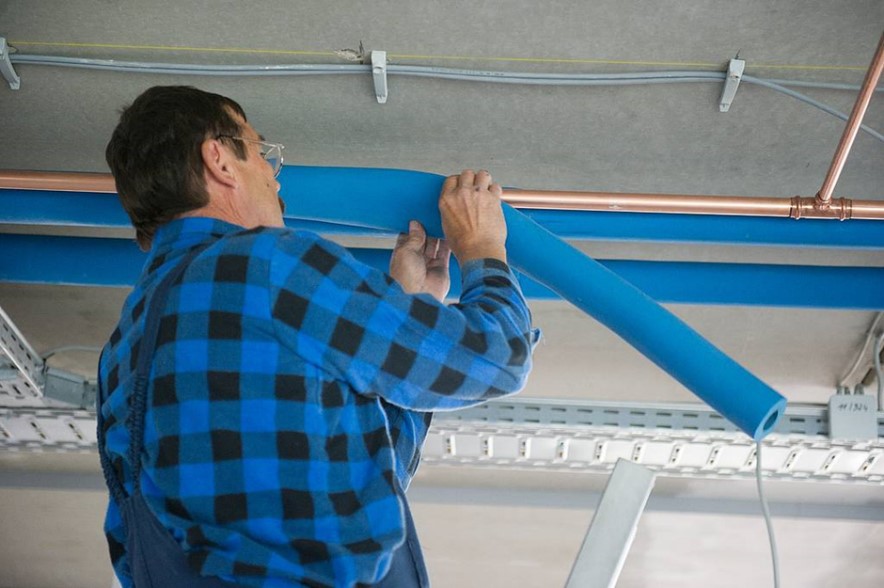

|
Edward Lowton
Editor |


|
| Home> | Premises management/maintenance | >HVAC | >Condensation control |
Condensation control
03 October 2016
Correctly specified insulation can prevent condensation forming on air conditioning pipework. Anthony Barnett technical marketing manager at Armacel UK, looks at how recent advances in product performance and availability of BIM Objects are helping in this area.

The primary concern with air-conditioning pipe and ductwork is that surface condensation may occur. Condensation not only accelerates the rate of pipe corrosion but can also severely impact on the heath of building occupants because of mould growth, leading to proliferation of airborne bacteria which exacerbates some breathing related conditions.
On air conditioning systems the line temperature is lower than the ambient temperature and so condensation is liable to form when water vapour in the air comes into contact with colder surfaces of the pipework and equipment. Eventually, this condensation results in considerable damage and there may be further maintenance costs resulting from wet ceilings, spoilt goods or disruption to production processes. Moreover, the insulation effect of a material deteriorates greatly when it becomes damp, resulting in large increases in energy use.
Buildings that have high occupancy are more susceptible to condensation because each person produces around 0.5 litres of moisture per day just through breathing. When this is multiplied by several hundred, which is possible in buildings such as offices, schools and hospitals, this airborne moisture can result in significantly build-up of condensation when it comes into contact with poorly insulated air conditioning pipework.
It is possible to calculate the respective water vapour content of this air at a given temperature to work out the extent to which air of a certain relative humidity can cool without 100% saturation being exceeded and therefore condensation forming. Applying this physical law to air conditioning applications means that the insulation thickness must be designed so the temperature never falls lower than the dew point anywhere on the surface of the insulation material.
In order to prevent condensation, the surface temperature of the insulation must be as high as, or higher than the dew point temperature under defined ambient conditions. Armacel UK's ArmWin Thermal Insulation Thickness Program offers a relatively straightforward way of calculating insulation thickness.
BIM for insulation
To avoid condensation on air conditioning pipework, low-temperature insulation must be correctly specified and be able to perform over the long term, even under critical conditions. A key element of this is ensuring that the correct insulation thickness has been used. Another critical factor is the quality of both the material and the installation, since this has a dramatic effect on performance. In order to help with this we now offer Armaflex product ranges free to download from the NBS National BIM library. BIM objects listed in the library include tube and sheet range products suitable for Revit Building Design software and in IFC format.
Aside from condensation issues, buildings consume around 40% of the UK’s energy, and so making BIM objects available ultimately leads to greater energy efficiency. Specifiers will now be able to use the BIM objects to create realistic, intelligent 3D models of a building to capture, explore and analyse data associated with heating, ventilation and air conditioning (HVAC) within the overall design model.
The information in these models remains consistent and available to everyone involved in the project and will ultimately result in more informed decision making around the specification of high performance flexible insulation to avoid condensation and reduce energy consumption.
We see huge potential in being able to help specifiers visualise and digitise a building projects lifecycle. Our new BIM objects allow rapid and meaningful energy analysis at the very early design stages and that will result in a huge potential to drive through huge improvements over the entire building lifecycle.
When specifying insulation for air conditioning systems it is necessary to take into account a number of factors. If unsuitable materials, inadequate insulation thicknesses or poor installation practices are used the air conditioning system becomes vulnerable to condensation and corrosion.
It is worth remembering that the minimum insulation thicknesses to prevent condensation are different to insulation designed to prevent energy losses. As the results of a study carried out show, much higher energy and carbon dioxide savings are possible if greater insulation thicknesses are specified. It may require a slightly higher investment however the pay back can be substantial if the savings are projected over the lifetime of the system. One of the most effective ways of calculating these savings over the life of the building is with latest BIM objects.”
- Insulation's sporting role
- Quick to install
- Condensation control
- Nitrile rubber materials awarded Green Guide 'A' rating
- Condensation control and insulation
- Insulation savings highlighted
- Technical insulation selector tool
- Insulation improved
- Calculator updated and mobile version launched
- Insulation redesigned

















